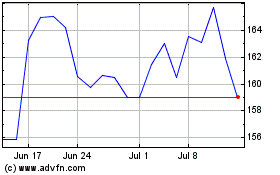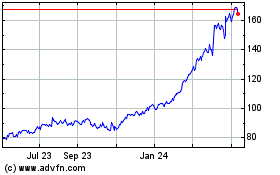By Thomas Gryta
This article is being republished as part of our daily
reproduction of WSJ.com articles that also appeared in the U.S.
print edition of The Wall Street Journal (January 30, 2020).
General Electric Co. reported strong cash flow from its
industrial operations and gave an upbeat outlook, as the
conglomerate reverses losses in its power business and continues to
draw support from its jet-engine division.
GE on Wednesday said it generated $3.9 billion in industrial
free cash flow in 2019's final quarter, helping the company exceed
its targets for the full year. Cash flow is essentially the money
left after a business pays its bills and makes investments.
GE executives projected cash flow and profit would rise in 2020,
as restructuring efforts and improved business conditions offset
challenges from the grounding of Boeing Co.'s 737 MAX jet. GE is
part of a joint venture that makes the engines for the airplane;
its financial projections assume the plane returns to service in
mid-2020.
"I'm pleased with the strong finish," GE Chief Executive Larry
Culp said in an interview. "The priorities coming into 2020 are
clear, but we are mindful that there is still a lot to do
here."
GE shares rose more than 10% to a new 52-week high on Wednesday.
The stock has rebounded from lows in the summer as Mr. Culp pursues
his plans to pare the company's debt and streamline operations.
Strapped for cash, GE has been selling off business units and it
slashed its dividend, most recently in late 2018.
The company said it will provide a detailed 2020 financial
outlook in early March.
For all of 2019, GE said it generated $2.3 billion in cash flow
from industrial operations, topping its goal of between break-even
and $2 billion. Early last year, Mr. Culp warned the company's core
operations might burn through as much as $2 billion in 2019, but
the outlook improved several times as he implemented this
turnaround plan.
After years of falling profits, investors and GE management are
focused on cash flow as the most important financial measure.
As is historically the case, GE relied on its fourth-quarter
results to meet its annual targets. In the first nine months of
2019, GE produced negative cash flow of $1.6 billion.
The Boston-based company has set a higher bar for 2020,
projecting cash flow of $2 billion to $4 billion, despite the
grounding of the MAX jet, the sale of its former oil and gas
business and the loss of cash generated by BioPharma. GE is
awaiting regulatory approval of the $21 billion sale of its
biotechnology business.
The grounding of 737 MAX jets after two fatal crashes cut GE's
cash flow by $1.4 billion in 2019, as expected. Nonetheless, the
aviation business -- the conglomerate's largest business by revenue
-- was crucial to sustaining the overall turnaround at GE by
providing $4.4 billion in cash flow.
Of GE's entire order backlog of $405 billion, the aviation
division accounts for $273 billion. In the fourth quarter, it
logged a 22% rise in orders.
Mr. Culp said the MAX issue remains a challenge for the
division, with engine shipments expected to drop by half this year.
GE will reduce its engine production for the MAX but won't go to
zero in anticipation of the plane's return to service.
For most of last year, Boeing was still producing MAX aircraft
and GE was delivering engines. But the planes weren't going to
customers, which meant delays in payments to GE; and now that
Boeing has paused MAX production, there is more uncertainty.
"We go from a relatively straightforward delay in 2019 to a more
fluid and complex operating environment in 2020," Mr. Culp said
Wednesday.
The grounding of the MAX, and its anticipated resumption of
service, is the "biggest swing factor" for GE's free-cash flow
projection for this year, he said.
In the fourth quarter, GE's net income fell 6% to $538 million
as the company continued to restructure its operations. Revenue
dropped 1% to $26.24 billion, exceeding analyst expectations of
$25.69 billion, according to FactSet. Excluding various items, GE
said it earned 21 cents a share, above the consensus view of 18
cents.
Orders for new equipment and services fell 3% from the
year-earlier quarter, excluding acquisitions and currency swings.
The decline was driven by a 30% drop for the division that makes
turbines for power plants.
The power division, which had been GE's biggest revenue
generator, has been at the center of GE's financial and operational
woes. Mr. Culp set out to overhaul the business, and it has since
been separated into two units.
The century-old business has suffered deep losses amid a global
drop in demand for power-generating equipment. It has cut thousands
of jobs to adjust to the market, but GE expects it will take years
to get the division back on track.
Mr. Culp said the business is now more conservative in pursuing
contracts. In the fourth quarter, there were no deals to build
entire power plants, a business GE entered with the acquisition of
Alstom in 2015.
"What we are trying to do is be more disciplined and more
thoughtful about when and where we sign up to do more than deliver
just a gas turbine," Mr. Culp said. Such deals, he said, can be
difficult to meet performance and schedule requirements, making it
harder to achieve margins that make them worthwhile.
The sale of GE's biotechnology business to Mr. Culp's former
company, Danaher Corp., received conditional clearance in Europe
last month, and GE's 2020 projections assume its closing by the end
of March. The company plans to use the proceeds to pay down
debt.
For 2020, GE expects industrial revenue growth in the
low-single-digit percentage range and adjusted earnings of 50 cents
to 60 cents a share. On that basis, it had an adjusted profit of 65
cents in 2019.
Write to Thomas Gryta at thomas.gryta@wsj.com
(END) Dow Jones Newswires
January 30, 2020 02:47 ET (07:47 GMT)
Copyright (c) 2020 Dow Jones & Company, Inc.
GE Aerospace (NYSE:GE)
Historical Stock Chart
From Mar 2024 to Apr 2024

GE Aerospace (NYSE:GE)
Historical Stock Chart
From Apr 2023 to Apr 2024
